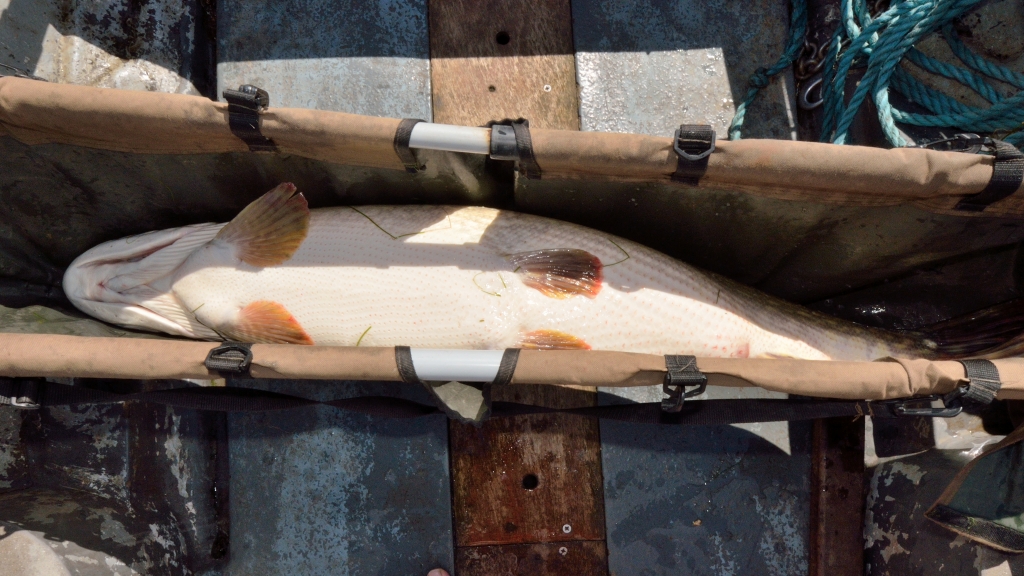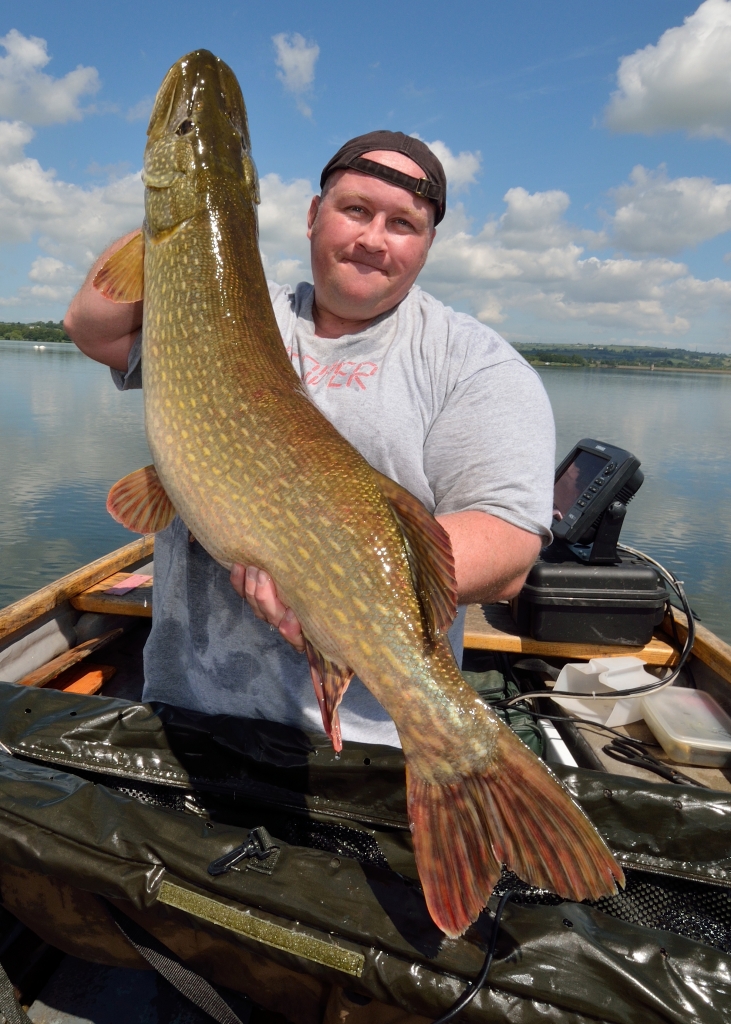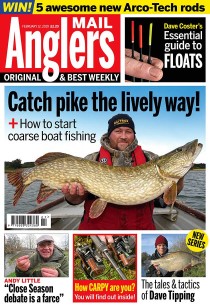June Blog 2014 – On the Fly
Fly fishing for predators is something I love doing when I get the opportunity. It’s not that that I think it’s the be-all and end-all, the pinnacle of fishing or anything like that. It’s just a good method in the right conditions that catches fish. There are occasions when lures will out- fish flies, and other times when flies will beat lures.
The thing with fly fishing is you can work your lure very slowly if you want to, something that you can’t do with many other methods, and I have come to think this is the key to catching big fish with the fly. It’s something that “Pike Fly Guru” Nigel Savage has always said, “Strip if you want to catch jacks”. This is where 99% of fly anglers get it wrong, there is a tendency to work the fly back too fast, and, especially where the pike are heavily fished for, this can be the worst kind of retrieve.
If you look at a shoal of freshwater bait fish, most of the time they are not moving at all, they move in quick darts then hold position – if the shoal is traveling any distance they move very slowly indeed unless disturbed. Hence why I like to fish my fly a slowly as possible, so it looks like a normal bait fish without a care in the world in the water, and is easy pickings for any big pike it passes. Slow retrieve styles also have the benefit that you don’t have to keep casting so much, possibly disturbing fish in the process.
There are also certainly some pike flies that are better than others, and it’s not just a colour thing, it’s how they are tied and how they work in the water. Some of my best flies have hardly any action, which I think is important when working them slow, as you want that bait fish silhouette to stand out.
I was too busy with work to get out at all in April and May, which are two of the absolute best months for pike fishing. It is often quoted that after spawning pike eat up to 80% of their yearly consumption of bait fish in this two months. So it is a good time to be out regarding catch ability, though often the pike at this time of year can still be a bit battered from spawning, and they are not at their heaviest weight. Also the conditions were not great – with it often being quite cold and windy in both months. To be honest not much was coming out of the local reservoirs, and I was enjoying having a bit of time off from fishing. But that didn’t last long as two things happened. Firstly Sam Edmonds pulled out a 30lber from a local reservoir, and secondly I found out that my friend Paul Clydesdale had been doing well, and had caught a monster 36lb pike from Chew on the fly.
That was all the incentive I needed and I dusted off my pike fly gear, sharpened my pike flies and re-spooled my reels. The first trip was to Rutland to blow away the cobwebs, and get my casting shoulder warmed up!
I like Rutland, it’s one of my favorite waters and I seem to do well on there. It’s not the big fish water of the AW reservoirs, though occasionally big fish do come out, and I like fishing it. So I had a couple of half day boats on there and caught a few fish, but nothing over 15lbs, which was a bit disappointing. What was strange though is that the fish were all in very shallow water (for Rutland), usually you are looking at this time of year for 18 – 28 ft to fish in, but all the fish I had came from less than 6ft of water and fought like Irish pike! Great fun. I also got stuck into some big perch, which came as a nice surprise.
Next step was a trip to Chew for some bigger fish, more often than not easier said than done, especially where Chew is concerned. But I was confident in my tactics for there, that have always suited me well, fish with a floating line and fast- sink poly leader to get the fly down, then slowly fish the “bend” as the boat drifts, twitching the fly in as it makes its progress back to the boat.
Unfortunately the conditions on the day I booked were terrible for fishing, red hot and no wind! Perfect pike fishing conditions! Oh well, I thought it would be ok for the first few hours before the sun got too high, then I could have a break and fish hard in the evening when it cooled down.
I got the boat loaded up and headed down to one of the bays that is usually productive, and I was surprised to see I was the only one out, and to top this there were pike rolling everywhere! Not striking at bait fish, but rolling. I’ve seen this happen before at Rutland and Windermere, and usually if you cover the fish they are quite catchable. But I went from boil to boil, casting at each fish, and they were having none of it. It was getting really frustrating, and after two hours I left them to it. I must admit it did hurt to leave those fish rolling like they were, but I had covered a good few fish, and I was sure I was fishing well, so I should have caught if they were feeding. Looking back every time I have seen this behaviour it has been associated with high pressure, maybe the pike roll to get air into their gas bladder? One of the wardens tried to tell me that they were feeding on buzzers on the surface, but I don’t think they were doing this, and it does seem a funny thing for big pike to do.
Anyway, I then found out that yesterday had seen a pike fly fishing competition on the lake, which explained why I was the only boat out! So I made the decision to fish areas well away from the normal productive spots, as I suspected these had been hammered the day before. This proved to be a good choice as after three casts something hit the fly like a 20 ton truck. I pulled on line to set the hook, not that it really needed it, and the fish chugged off into deep water, pulling the boat along with it.
The beauty of using a good strong 10 weight rod is that you can really pile the pressure on the fish, fly rods bend right down to the butt and you can really double them up to control the fish, and I’d got mine locked up tight on this one – the clutch was screwed up to maximum once all the line was back on the reel, leaving nowhere for the fish to go other than plunge around under the boat and tire itself out. This worked well and the fish soon popped up right next to the boat. It was massive- a good twenty, just out of netting range and turning water with its tail like they do when they are about to teach you a lesson. I decided to go for it and went to net it. But as I thought, the fish kicked its massive tail and powered off, pulling the boat around as it did so, this happened twice before I finally got it in the net, and when I got it in the net what I thought was a good twenty started to look bigger!
I got the sladle out and quickly unhooked this fish and weighed it. It wasn’t a big 20 at all, it was a 30! … 33lb 2oz to be exact! WOW. The fish was well proportioned and built like an ox, I wonder how big this fish will be in the Winter? I wish I had measured it but I was concerned about having it out the water for too long, and didn’t want to faff around with it so I put it in the floating sling while I set the camera up.
I have a Prowla floating sling which is absolutely the best thing to put a pike in while you organize yourself, a lot of anglers will say it is best to leave them in the net- well yes, you can do this if you are two up on the boat, but even then they can jump out, and the mesh on a net is not as fish friendly as a soft sling. The sling floats out away from the boat so the fish isn’t being banged around alongside, like being in a net.
Once the camera was set up, I quickly pulled the sling back in, and with the fish safely back in the sladle I took a couple of quick photos before watching her waddle off back to the depths. Chuffed to bits with a new PB when, if I’m honest, I wasn’t expecting much at all.
Now with the water temperatures really rising it’s time to leave the pike alone for a bit and concentrate on some other predators for the summer months.










